|
Know what’s happening across Oceania—before your coffee’s cold.

Self-sampling offers a convenient and less invasive alternative to traditional clinician-collected tests, helping increase participation in cervical cancer screening programs. Photo Credit: Cancer Society New Zealand
Self-Testing Revolutionizes Cervical Screening: More Convenient, Comfortable, and Effective
|
Cervical cancer screening is undergoing a transformative change thanks to the rise of self-sampling tests, which are proving to be a game-changer in increasing participation, comfort, and early detection.
|
The Otago Study: Making Screening Easier and More Accessible
|
A recent study led by researchers at the University of Otago has shown that self-testing for cervical cancer can significantly improve the screening experience for women. Traditionally, cervical screening requires a pelvic exam conducted by a healthcare professional, which can be uncomfortable and a barrier for many women.
|
|
The Otago study found that allowing women to collect their own samples at home or in a private setting increased convenience and reduced anxiety. Participants reported that self-testing was more comfortable and less invasive, which could lead to higher screening rates and earlier detection of precancerous changes.
|
Why Cervical Screening Matters
|
Cervical cancer is largely preventable through early detection and treatment of precancerous lesions, primarily caused by persistent infection with high-risk human papillomavirus (HPV) types. Regular screening is critical, but participation rates vary due to factors such as embarrassment, discomfort, and access to healthcare.
|
Global Evidence Supporting Self-Sampling
|
Supporting the Otago findings, multiple international studies have demonstrated that HPV self-sampling is as accurate as clinician-collected samples for detecting high-risk HPV strains. For example:
|
- A 2023 meta-analysis published in The Lancet showed that self-collected HPV samples had comparable sensitivity and specificity to clinician-collected samples, with the added benefit of reaching women who are underscreened or never screened.
- The World Health Organization (WHO) now recommends HPV self-sampling as an alternative to clinician-based screening, especially in low-resource settings or populations with low screening uptake.
|
Benefits Beyond Comfort
|
Self-sampling not only improves comfort but also addresses logistical barriers such as travel distance, clinic hours, and cultural sensitivities. Women can perform the test in privacy, at a time that suits them, and send samples by mail for laboratory analysis.
|
|
This approach is particularly promising for:
|
- Rural and remote communities
- Women with mobility or health challenges
- Populations with cultural or language barriers
- Those hesitant to undergo pelvic exams
|
Challenges and Considerations
|
While self-sampling offers many advantages, successful implementation requires:
|
- Clear instructions and education to ensure proper sample collection
- Reliable laboratory infrastructure for HPV testing
- Follow-up systems for women who test positive to receive timely care
|
|
Healthcare providers must also address concerns about test accuracy and reassure patients about the reliability of self-collected samples.
|
The Future of Cervical Cancer Screening
|
The shift towards self-sampling aligns with the global goal set by the WHO to eliminate cervical cancer as a public health problem by 2030 through vaccination, screening, and treatment.
|
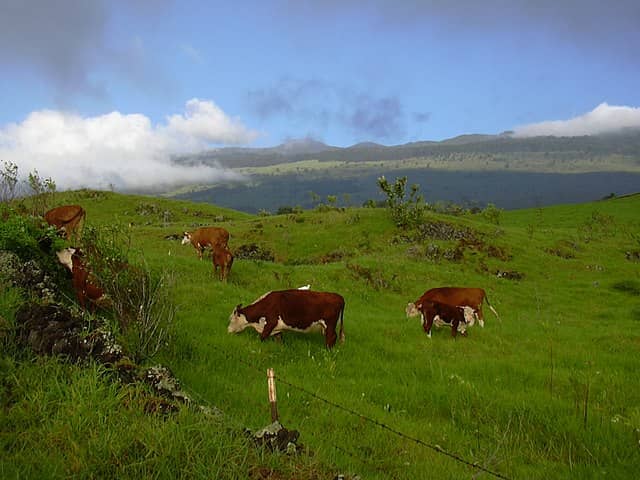
Cattle graze on open pastureland in Maui, Hawaiʻi. Local ranchers and farmers are reeling after the USDA cut $46 million in funding for climate-smart agriculture, threatening jobs and future sustainability efforts. Photo Credit: "Maui Cattle Grazing" by Forest & Kim Starr, from Wikimedia Commons, licensed under CC BY 3.0 US
USDA Cuts $46 Million in Funding for Hawaiʻi Farmers and Ranchers: What’s at Stake?
|
The U.S. Department of Agriculture (USDA) has abruptly cut $46 million in funding intended for Hawaiʻi farmers and ranchers, a move that has sent shockwaves through the islands’ agricultural sector and raised concerns about the future of climate-smart farming initiatives. The funding, part of the Biden-era Partnership for Climate-Smart Commodities (PCSC), was designed to support a wide range of projects aimed at improving soil health, managing invasive species, and boosting local food production-all while reducing greenhouse gas emissions.
|
What Happened?
|
Agriculture Secretary Brooke Rollins, newly appointed under the Trump administration, announced the termination of the PCSC program, calling it a “Biden-era climate slush fund” and a “green new scam” that favored nonprofits over direct agricultural support. The USDA stated it would repurpose the funds under a new initiative, Advancing Markets for Producers (AMP), with new criteria that require at least 65% of funding to go directly to farmers, rather than to technical assistance or administrative costs.
|
|
However, the sudden cut has left at least 30 contracts with Hawaiʻi farmers and ranchers eliminated and up to 60 local jobs lost, with organizations scrambling to adjust or shut down programs entirely. For many, the wait until the reapplication period in June is too long to bridge the funding gap, resulting in layoffs and uncertainty.
|
Local Impact
|
The PCSC program had a significant footprint in Hawaiʻi. It involved more than 30 farmers and ranchers in its first phase and planned to double that number in the coming months. Projects ranged from planting food forests to supporting agroforestry and soil conservation, all tailored to the unique needs of Hawaiʻi’s diverse agricultural community. The partnership was a collaboration among 12 organizations, including the University of Hawai‘i, Hawaiʻi Cattlemen’s Council, and the Hawaiʻi Farmers Union United.
|
|
The loss of funding is particularly acute for smaller farms and underrepresented communities, which often rely on technical assistance and capacity-building support-not just direct payments-to implement climate-smart practices. “It sounds good in theory, that you want the majority to go to the farmer,” said U.S. Rep. Jill Tokuda, “But I think it favors the larger producers, the larger entities, when really we’re looking at how to provide support to smaller and underrepresented communities”.
|
A Broader Pattern of Cuts
|
This is not an isolated incident. Since the Trump administration began aggressively curtailing federal spending earlier this year, Hawaiʻi’s agricultural sector has seen over $60 million in federal funding frozen or canceled-more than the state Department of Agriculture’s annual budget. Nationwide, nearly $90 million destined for Hawaiʻi and Pacific region farmers and food organizations has been jeopardized, with ripple effects threatening local food banks and food security programs.
|
|
The cuts extend beyond climate-smart initiatives. Funding for local food purchase and school meal programs-critical for addressing food insecurity-has also been slashed, with advocates warning of a “chilling effect” on both food producers and vulnerable communities.
|
What’s Next?
|
The USDA has invited some organizations, such as the Lynker Corporation and University of Hawaiʻi, to reapply for funding under the new AMP program. However, others, like the Hawaiʻi ʻUlu Cooperative, have been excluded from the opportunity to reapply, further compounding the sense of loss and frustration. Many fear that the new program’s focus on direct payments will come at the expense of the technical support and education that small and mid-sized farms need most.
|
|
The uncertainty and disruption caused by these abrupt changes threaten to undermine years of progress in making Hawaiʻi’s food system more resilient, sustainable, and locally focused. As organizations regroup and consider their options, the future of climate-smart agriculture in Hawaiʻi hangs in the balance.
|
Key Takeaways:
-
$46 million in USDA funding for Hawaiʻi climate-smart agriculture has been cut, eliminating jobs and contracts.
-
The new AMP program prioritizes direct payments to farmers but may disadvantage smaller operations that rely on technical assistance.
-
Broader federal cuts threaten nearly $90 million in support for Hawaiʻi and Pacific region food systems, including food security programs.
-
The long-term impact could be a setback for local food production, climate resilience, and community well-being.
|
|
As the situation evolves, Hawaiʻi’s agricultural community faces a critical test of resilience and adaptability in the face of shifting federal priorities.
|
PRESENTED BY VONU STUDIOS
Oceanian Animated Videos For Kids: Pawpaw Kids TV
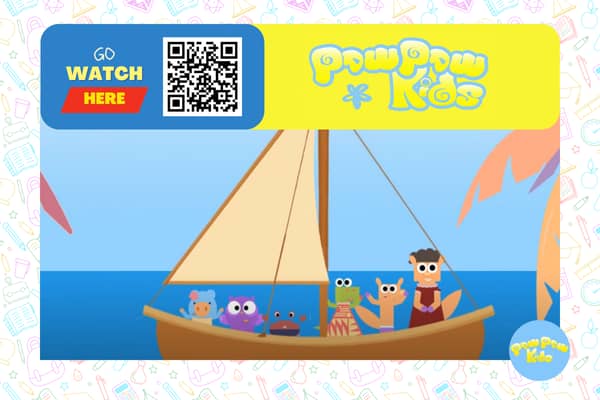
|
Pawpaw Kids TV is a YouTube channel dedicated to engaging and educational content for children, with a specific focus on the Oceanian region. The channel features the Pawpaw Explorers—Illy the Iguana, Mo the Mongoose, and other animated characters—who embark on adventures that introduce young viewers to local wildlife, ocean currents, and cultural stories.
|
Pawpaw Kids TV offers a Pacific blend of entertainment and learning, making it a valuable resource for children to explore the rich cultures and natural wonders of the Oceania region. Simply scan the QR code to visit the Pawpaw Kids TV YouTube channel or click this link:
YouTube Link: Pawpaw Kids TV
|
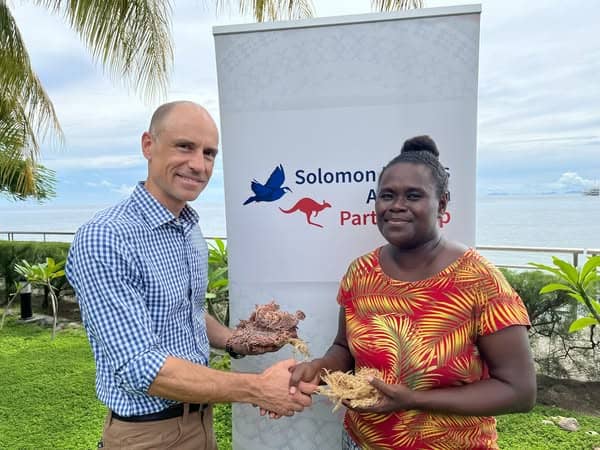
Australian Deputy High Commissioner, Andrew Schloeffel met with Managing Director of LG Marine Enterprise, Lydia Sogabule. LG Marine Enterprise supports over 15 community-based seaweed farmer groups in the Solomon Islands, with Australia helping expand exports to Australia and the UK, boosting incomes and sustainable livelihoods. Photo credit: Australian High Commission, Solomon Islands - Facebook
Australia Partners with LG Marine Enterprise to Boost Solomon Islands’ Seaweed Exports and Farmer Incomes
|
Australia is strengthening its economic partnership with the Solomon Islands by collaborating with local business LG Marine Enterprise to grow the country’s seaweed export industry and create more jobs for community-based seaweed farmers. Australian Deputy High Commissioner Andrew Schloeffel recently met with LG Marine’s Managing Director, Lydia Sogabule, to discuss ongoing support that has helped expand access to higher-value overseas markets.
|
|
With Australia’s assistance covering freight and handling costs, LG Marine successfully exported 60 tonnes of seaweed to Australia, valued at approximately SBD 420,000 (USD 46,830). This seaweed will be used as a climate-friendly animal feed that reduces methane emissions. Additionally, another 120 tonnes were shipped to the UK, worth about SBD 840,000 (USD 93,660), destined for cosmetics, pharmaceuticals, and medical products such as ultrasound gel.
|
|
Over 15 community-based farmer groups supply seaweed to LG Marine, and the partnership aims to increase demand and secure better prices, directly benefiting local farmers, including women and youth. Lydia Sogabule expressed enthusiasm about expanding the business and supporting the livelihoods of those producing high-quality seaweed.
|
|
This collaboration exemplifies Australia’s commitment to supporting small businesses and sustainable economic development in the Solomon Islands, contributing to job creation and climate-friendly industries.
|
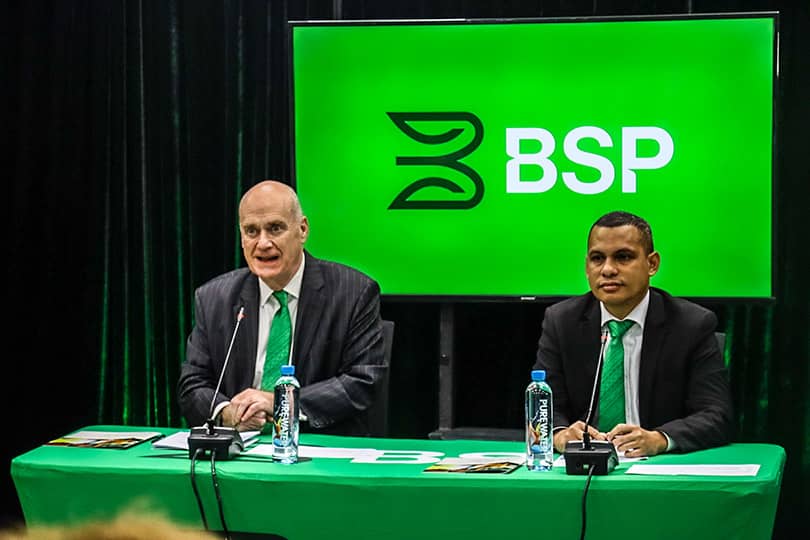
(L-R) BSP Group CEO Mark Robinson and Head Of Business Bank Raymond Logona seated during the press conference. Photo credit: BSP
BSP Launches Dedicated Business Bank to Support SMEs Across Papua New Guinea
|
Bank South Pacific (BSP) has officially launched its new Business Bank, a dedicated service designed to empower small and medium-sized enterprises (SMEs) throughout Papua New Guinea. The launch event took place on April 30, 2025, at BSP’s Gordons Commercial Centre in Port Moresby, marking a significant milestone in the bank’s modernization and growth strategy.
|
|
BSP Chief Executive Officer Mark Robinson emphasized that the Business Bank is central to BSP’s commitment to evolving its services to better meet the needs of PNG’s diverse business community-from startups to expanding enterprises. “This is business banking designed for Papua New Guinea-most importantly, designed for growth,” Robinson said.
|
|
The Business Bank aims to provide more mobile, accessible, and agile support, reaching customers even in remote and regional areas. It offers a comprehensive suite of tailored products and services including business accounts and cards, lending options, overdrafts, asset financing, EFTPOS, payroll services, online foreign currency and international transfers, as well as secure online and mobile banking.
|
|
Raymond Logona, Head of BSP Business Bank, highlighted the creation of the Business Bank Hive-a specialist team of product experts in digital banking, payments, leasing, and foreign exchange who collaborate closely with relationship managers to deliver customized solutions for business clients.
|
|
In addition to banking products, BSP has partnered with Australian Business Volunteers (ABV) to deliver nationwide business and financial education workshops. These workshops focus on practical skills such as cash flow management, business planning, tax basics, marketing, and ongoing mentorship, helping entrepreneurs build stronger, more sustainable businesses.
|
|
This initiative reflects BSP’s broader strategy to support economic growth by nurturing PNG’s SME sector, which is vital for job creation and community development across the country.
|
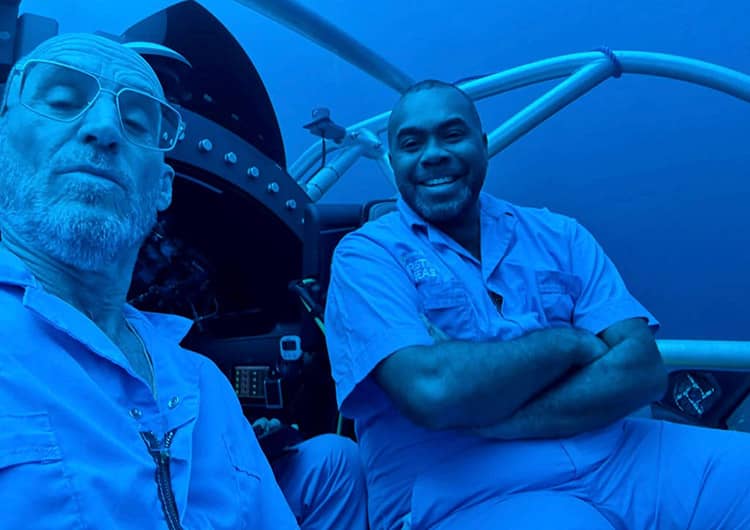
Hon. Mosese Bulitavu, Fiji’s Minister for Environment and Climate Change, aboard National Geographic Pristine Seas’ deep-sea submersible Argonauta, just off Port Denarau. Photo credit: Pristine Seas
National Geographic Pristine Seas Launches Major Expedition to Explore Fiji and Rotuma’s Marine Biodiversity
|
A team of international and local scientists and filmmakers from National Geographic Pristine Seas has embarked on a landmark expedition to study and document the rich marine ecosystems surrounding Fiji and Rotuma, a self-governing dependency of Fiji. The expedition, running from April through September 2025, aims to fill critical knowledge gaps about these biodiverse waters and support Fiji’s goal to protect 30% of its ocean by 2030.
|
|
The research vessel Argo, equipped with the advanced deep-sea submersible Argonauta, will explore environments ranging from shallow coral reefs to deep-sea habitats down to 1,300 meters. Rotuma, located about 465 km northwest of Fiji’s main island, is a volcanic island whose deep-sea ecosystems have never before been scientifically studied, offering the potential to discover new species and unique biodiversity.
|
|
The expedition includes environmental DNA (eDNA) sampling, SCUBA surveys, micropaleo sampling, and seabird counts. It also involves collaboration with local scientists and communities, integrating traditional knowledge with scientific research. The team will study key marine areas such as the Great Astrolabe Reef, the Great Sea Reef, and the Melanesian Border Plateau, a vast undersea volcanic ridge system spanning several Pacific nations.
|
|
Chairman of the Council of Rotuma, Gagaj Manav, welcomed the expedition, emphasizing the community’s commitment to protecting their ocean heritage through science and cooperation. Fiji’s Ministry of Environment and Climate Change highlighted the importance of this research for identifying marine biodiversity hotspots and informing effective ocean management.
|
|
The expedition is part of National Geographic Pristine Seas’ five-year Global Expedition across the tropical Pacific, building on prior research in countries including Papua New Guinea, Solomon Islands, and Palau. It also features educational outreach, with opportunities for students and teachers to engage directly with the scientists aboard Argo.
|
SPORTS
Wallaroos Arrive in Fiji for Historic Test Match Against Fijiana

The Wallaroos squad training in Suva ahead of their historic Test match against the Vodafone Fijiana XV at HFC Bank Stadium on May 3, 2025. Photo Credit: Facebook
|
The Australian Wallaroos women’s rugby team has arrived in Suva, Fiji, ahead of their historic Test match against the Vodafone Fijiana XV this Saturday, May 3, 2025, at HFC Bank Stadium. This will be the first time the Wallaroos play a Test on Fijian soil, marking a significant milestone in the growing rugby rivalry between the two nations.
|
Team and Leadership
|
Nine players from the Safeguard Global ACT Brumbies have been selected for the Wallaroos squad, including captain Siokapesi Palu, who will lead the side for this opening Test and the upcoming Pacific Four series. The squad features a blend of experienced players and promising debutants such as Katalina Amosa, Martha Fua, Ashley Fernandez, and Tia Hinds. Vice-captain Emily Chancellor returns after recovering from a long-term knee injury.
|
Preparations and Expectations
|
Upon arrival, the Wallaroos coaching staff conducted a clarity session in Suva to ensure the team is aligned on game plans and individual roles. Coach Jo Yapp expressed confidence in the squad’s depth and chemistry, highlighting the opportunity to test new combinations and see how players respond to Test rugby in challenging conditions.
|
|
Yapp acknowledged the passionate home crowd and the challenge posed by the Fijiana team, emphasizing the importance of playing with pride and resilience in front of Fijian supporters.
|
The Vuvale Bowl: A Symbol of Friendship
|
The match will also inaugurate the Vuvale Bowl, a new trophy symbolizing the strong ties and sporting friendship between Australia and Fiji. The Wallaroos and Fijiana players, along with dignitaries including Fiji’s Deputy Prime Minister Manoa Kamikamica and Australian High Commissioner Peter Roberts, gathered in Suva for a formal welcome ahead of the game.
|
Match Details
-
Date: Saturday, May 3, 2025
-
Time: 3:00pm AEST / 5:00pm Fiji Time
-
Venue: HFC Bank Stadium, Suva, Fiji
-
Broadcast: Live and on-demand via Stan Sport (Australia) and VITI+ (Fiji)
|
|
This Test match is a warm-up ahead of the Wallaroos’ Pacific Four series and is expected to be a fiercely contested game, showcasing the rising talent and growing competitiveness of women’s rugby in the Pacific region.
|
OCEANIAN MAKING WAVES
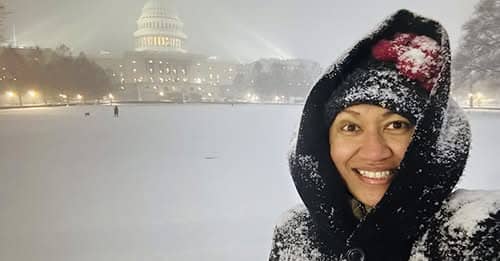
Fulbright scholar and University of Otago alumna DR Sainimere Boladuadua taking in the sights at Capitol Hill while studying at Johns Hopkins Bloomberg School of Public Health’s Center for Indigenous Health. Photo Credit: University of Otago
Fulbright Fellow Dr. Sainimere Boladuadua Champions Health Equity for Underserved Indigenous Communities
|
Dr. Sainimere Boladuadua, a distinguished Otago medical alumna and public health physician, is making significant strides in improving healthcare access and outcomes for Indigenous and underserved populations through her prestigious Fulbright Science and Innovation Graduate Scholarship. Currently undertaking a fellowship at the Johns Hopkins Bloomberg School of Public Health’s Center for Indigenous Health in the United States, Dr. Boladuadua’s work bridges Indigenous knowledge and Western medicine to tackle health disparities.
|
A Journey Rooted in Service and Cultural Identity
|
Born and raised in Fiji, Dr. Boladuadua’s academic journey began at the University of Otago, where she earned her MB ChB in 2002, followed by a Diploma in Obstetrics and Gynaecology from the Fiji School of Medicine and a Master of Public Health with Distinction from Otago. She credits her upbringing and cultural heritage as a driving force behind her commitment to serve her communities in Fiji, Aotearoa New Zealand, and beyond.
|
|
“As an iTaukei woman, I represent my family, my villages, my vanua,” she says. “All my work, including my achievements and failures, are a reflection on them.” This deep sense of responsibility fuels her dedication to addressing health inequities faced by Indigenous peoples.
|
Fulbright Fellowship: Learning Across Borders
|
At Johns Hopkins, Dr. Boladuadua is part of the Infectious Diseases prevention team, contributing to the Surveillance for Respiratory Syncytial Virus (RSV) and other respiratory infections among American Indians and Alaska Natives (SuNA) study. Her focus on analyzing human metapneumovirus among hospitalized Indigenous children and adults highlights the disproportionate burden of infectious diseases in these communities.
|
|
Her fellowship offers a unique opportunity to engage with Indigenous health leaders and traditional knowledge systems among Navajo and White Mountain Apache communities. This cross-cultural exchange enriches her understanding of how Indigenous and Western health practices can complement each other to improve healthcare access and outcomes.
|
Addressing Structural Inequities Through Research and Advocacy
|
Dr. Boladuadua’s work also involves exploring the historical and structural factors contributing to health disparities. Her time in the U.S. has deepened her insight into Native American history, tribal governance, and the Indian Health Service (IHS) system, illuminating the complex challenges Indigenous peoples face in achieving health equity.
|
|
She emphasizes that improving Indigenous health is not only about medical interventions but also about recognizing and integrating cultural values, community leadership, and traditional healing practices.
|
Global and Local Impact
|
Beyond research, Dr. Boladuadua actively participates in leadership forums and educational initiatives, such as delivering guest lectures on decolonizing global health and sharing Pacific perspectives on Indigenous wellbeing. Her engagement with international Indigenous health networks, including dialogues with Greenland’s Inuit leaders, underscores the global relevance of Indigenous health equity.
|
|
Back home, she envisions applying her learnings to strengthen health systems in Fiji and New Zealand, advocating for culturally responsive healthcare that respects Indigenous worldviews and addresses systemic barriers.
|
Why This Matters
|
Indigenous populations globally experience significant health disparities, including higher rates of infectious diseases, chronic conditions, and barriers to healthcare access. Efforts like Dr. Boladuadua’s fellowship are vital in advancing culturally informed public health strategies that empower communities and drive sustainable change.
|
|
Her journey exemplifies how international collaboration, respect for Indigenous knowledge, and commitment to social justice can transform health outcomes for underserved populations.
|
SPOTLIGHT
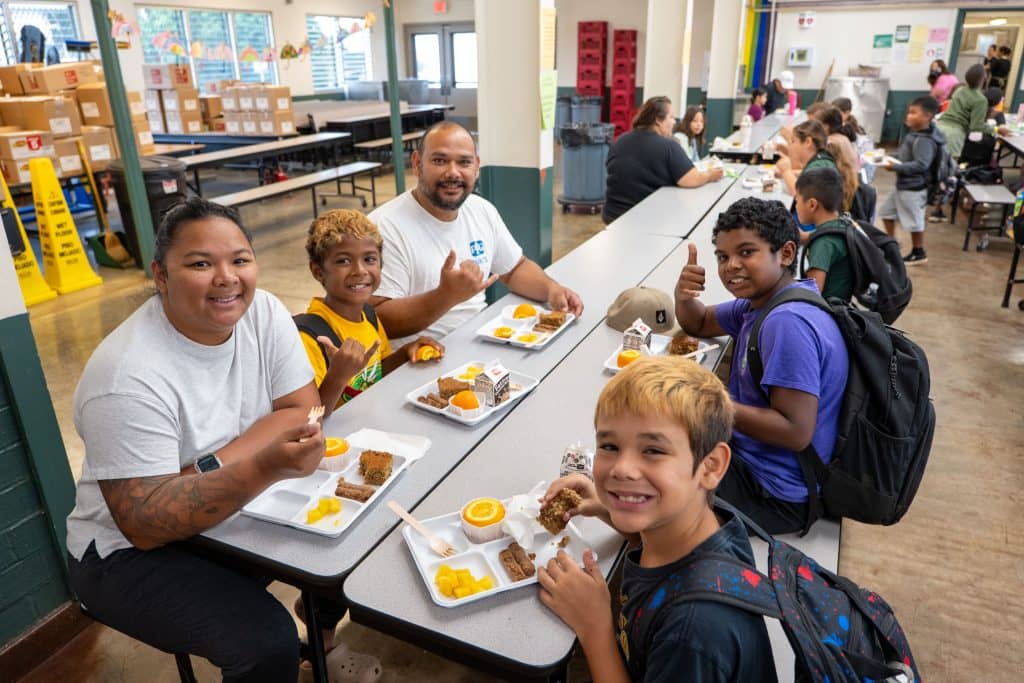
Students and parents at Helemano Elementary enjoy banana bread made with locally sourced ʻulu flour, part of Hawaiʻi public schools’ pilot program to boost nutrition and support local agriculture. Photo credit: HIDOE
Hawaiʻi Public Schools Pilot Banana Bread Using Local ʻUlu (Breadfruit) Flour to Boost Nutrition and Support Farmers
|
Hawaiʻi public schools are embracing a new, locally inspired recipe by serving banana bread made with ʻulu (breadfruit) flour-a first-of-its-kind initiative aimed at promoting healthier meals while supporting Hawaiʻi’s farmers and environment.
|
A Taste of Hawaiʻi in School Cafeterias
|
Throughout April 2025, about 90 public schools, including Helemano Elementary, participated in a pilot program offering ʻulu banana bread for breakfast. The recipe, developed by Kaiser High School’s food services manager Christian Lee-Tomita and baker Edison Ching, incorporates approximately 240 pounds of ʻulu flour sourced from the Hawaiʻi ʻUlu Cooperative. Over 11,000 students enjoyed this nutritious treat made with local bananas when available.
|
Why ʻUlu Flour?
|
ʻUlu, also known as breadfruit, is a traditional staple in Hawaiʻi that is naturally gluten-free, low in fat, and rich in essential amino acids, fiber, and vitamins A, B, and C, along with minerals like phosphorus and iron. Beyond its nutritional benefits, ʻulu is a sustainable crop that grows on trees, making it an excellent ally in Hawaiʻi’s reforestation efforts. Each ʻulu tree produces about 450 pounds of fruit per growing season, helping reduce reliance on imported foods like potatoes and wheat flour.
|
Aligning with Farm-to-School and Local Food Initiatives
|
This pilot aligns with the Hawaiʻi State Department of Education’s farm-to-school initiative and Act 175, which focus on improving student health and supporting local agriculture. Public schools in Hawaiʻi serve over 100,000 meals daily, making them the state’s largest institutional food consumer. The Department is actively working to increase the percentage of locally sourced food in school meals, aiming for 30% by the end of the decade, although current local procurement stands at about 6%.
|
Looking Ahead: ʻUlu Flour as a Regular Ingredient
|
Following the pilot’s success, ʻulu flour is expected to become a regular ingredient in school menus starting in the next school year. The Department of Education has included ʻulu flour in its regular bidding process, allowing all schools statewide to purchase it alongside other staple ingredients. This expansion will also include other ʻulu products such as steamed and frozen ʻulu and kalo (taro), further embedding local crops into school nutrition programs.
|
Broader Benefits
|
Incorporating ʻulu into school meals offers multiple benefits:
|
- Health: Provides students with nutrient-rich, gluten-free options.
- Economic: Supports local farmers and the Hawaiʻi ʻUlu Cooperative, helping to grow the local economy.
- Environmental: Encourages reforestation and reduces food imports, lowering Hawaiʻi’s carbon footprint.
- Cultural: Revitalizes traditional Hawaiian foods and culinary heritage among keiki (children).
|
TID BITS

Athletics Vanuatu is fundraising to secure VT1.2 million needed for athlete training, equipment, and travel to compete at the 2025 Pacific Mini Games in Palau. Photo Credit: Facebook
Athletics Vanuatu Seeks VT1.2 Million to Fund Pacific Mini Games Preparation
Athletics Vanuatu is seeking VT1.2 million (about USD 10,000) to prepare for the upcoming 2025 Pacific Mini Games in Palau, highlighting financial challenges faced by the federation. The funds are needed to cover athlete training, equipment, and travel expenses to ensure competitive participation in the regional event scheduled for late June to early July 2025.
|
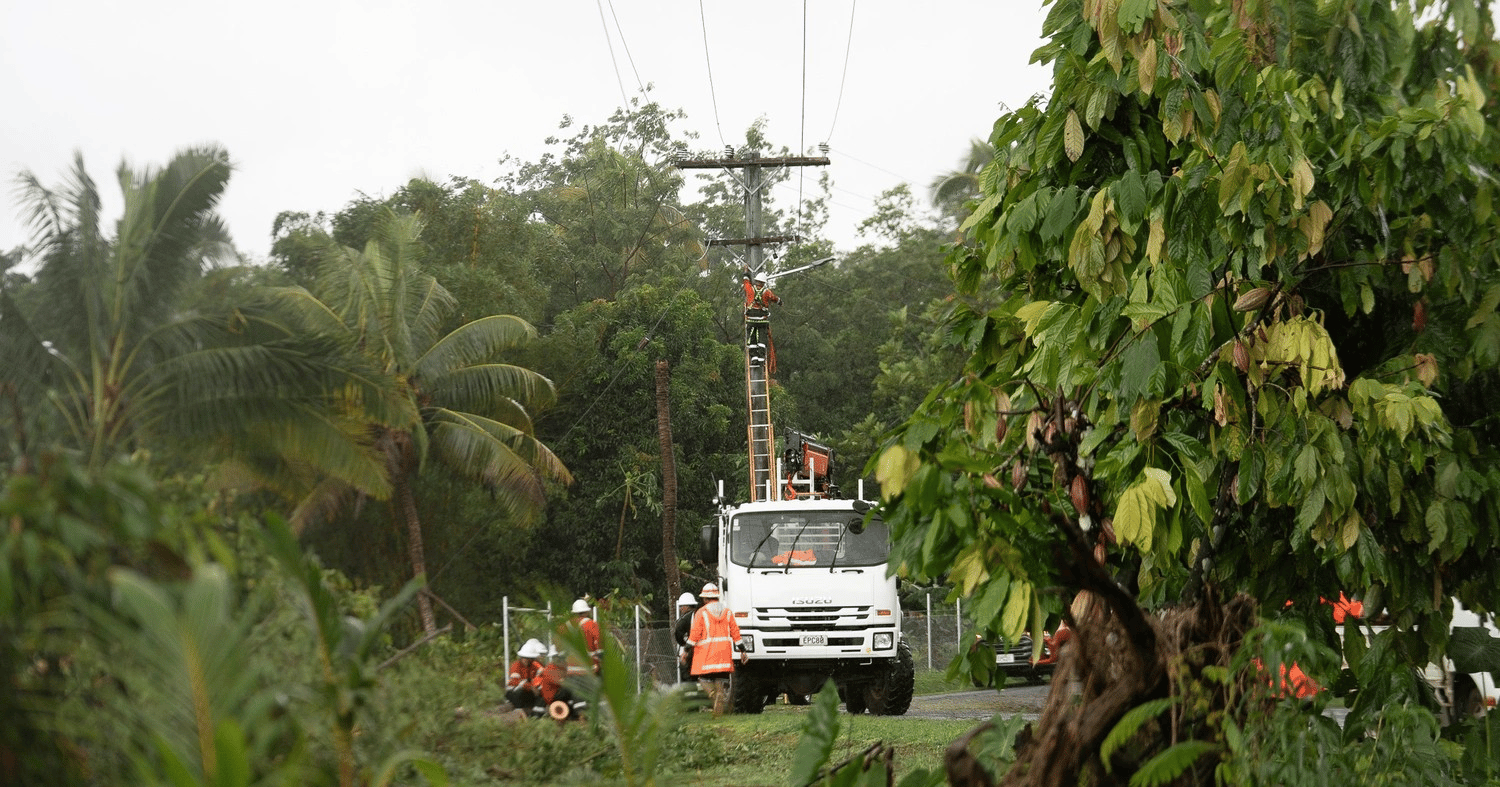
Japanese energy experts to assist Samoa’s Electric Power Corporation in upgrading infrastructure and improving grid reliability. Photo credit: Junior S. Ami
Japanese Experts to Assist Samoa’s Electric Power Corporation Amid Ongoing Energy Challenges
Samoa is partnering with Japan through JICA to bring in energy experts who will help the Electric Power Corporation (EPC) address ongoing power challenges. These experts will focus on technical assessments of power generation components, improving grid monitoring, and developing strategies to enhance system responsiveness, ensuring reliable electricity for Samoa.
|
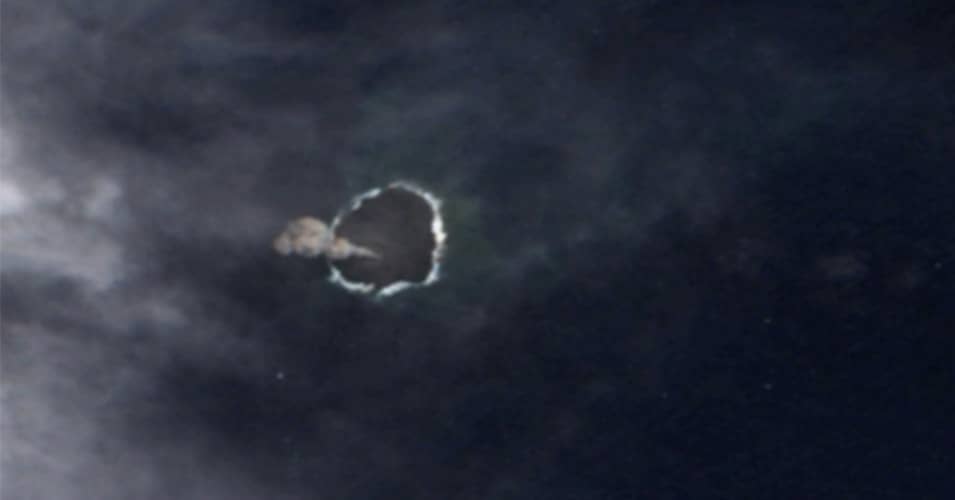
Satellite images reveal moderate thermal activity at Tonga’s Home Reef volcano, with ongoing monitoring to ensure safety. Photo credit: Tonga Geological Services, Government of Tonga - Facebook
Satellite Images Show Activity at Tonga’s Home Reef Volcano
Tonga's Home Reef volcano is exhibiting moderate thermal activity, as observed in recent satellite images showing volcanic steam and discolorations. While the activity poses a low risk to nearby communities, mariners are advised to stay at least two nautical miles away. The Tonga Geological Services continues to monitor the volcano to ensure public safety.
|
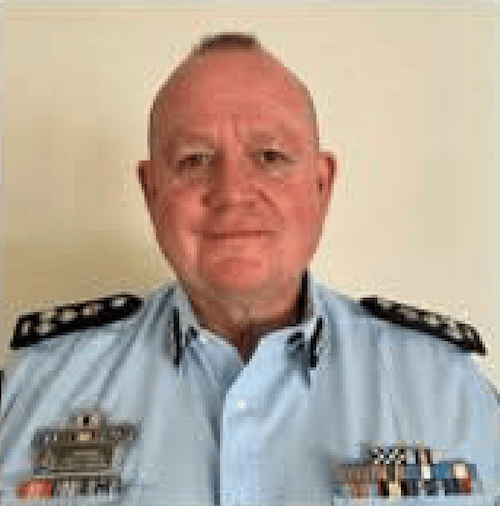
Commander Geoff Turner, incoming Police Commissioner of Tonga, brings decades of international policing experience to his new role. Photo credit: Tonga Police - Facebook
New Police Commissioner for Tonga to be Sworn In on 12 May
Commander Geoff Turner of the Australian Federal Police (AFP) in Canberra has been appointed as Tonga’s new Police Commissioner, with his swearing-in ceremony scheduled for 12 May 2025. Turner, a New Zealand-born officer with extensive international policing experience, will succeed Commissioner Shane McLennan, who is concluding his three-year term with Tonga Police.
|
Was this email forwarded to you? Sign up here:
|
|